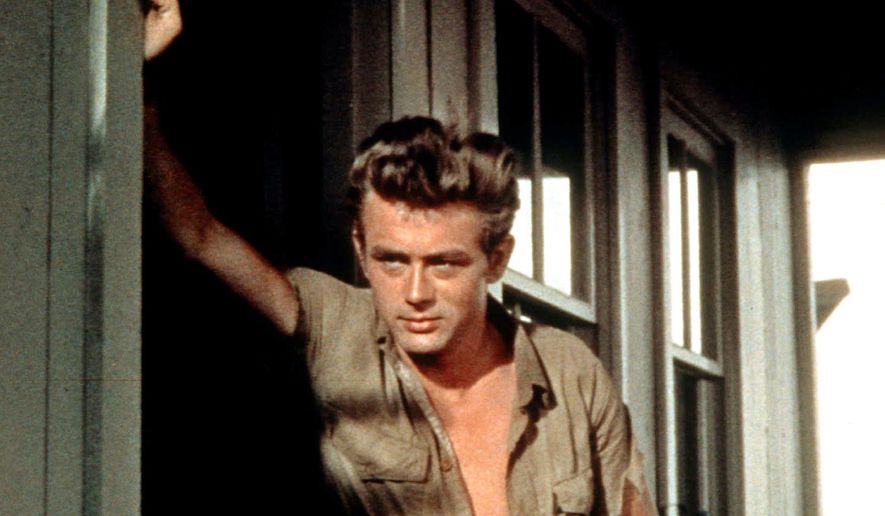James Dean is ready for his close-up — again.
Nearly 65 years after he died in a car crash at the age of 24, Dean is set to return to the big screen.
A production company for the upcoming film “Finding Jack” has cast Dean, or a computer-generated version of the long-dead star, in what is described as a “secondary lead” role. The move may prove a tough sell to movie fans and those involved with the film industry, though.
Based on a novel by Gareth Crocker, the film explores the hundreds of canine units left behind after the Vietnam War.
The Dean simulation would mark the actor’s fourth feature film credit, following “Rebel Without a Cause,” “East of Eden” and “Giant” in the mid-1950s. (“Finding Jack” hasn’t turned up yet on Dean’s IMDb page.) The production has the blessing of the Dean estate.
Allen Barton, an acting teacher with the Beverly Hills Playhouse, said Dean’s resurgence is part of a larger technological trend. Consider the rich animation in today’s best children’s films, which replicates our world in stunning fashion, Mr. Barton said.
Video games such as “Tom Clancy’s The Division 2” for PlayStation task actors to supply facial expressions and body movements for CGI artists to replicate. The results can be shockingly lifelike.
The question is whether it narrows the so-called uncanny valley, the relationship between how much an object resembles a human and how much creepiness it engenders in viewers.
“Is there something human underneath? That’s what’s going to be interesting to me,” Mr. Barton said about the Dean performance.
An actor to be named later will give the computerized version of Dean his voice. The rest will be up to a team of artists tasked with reproducing one of Hollywood’s most recognizable visages.
We’ve already seen versions of this computerized cinematic technique: The late Peter Cushing reappeared as Grand Moff Tarkin in 2016’s “Rogue One: A Star Wars Story.” The film limited his screen time, though, and the CGI version inhabited a character he created in 1977’s “Star Wars.”
Dean’s new role is different. It will be created from whole cloth — or, rather, from a series of ones and zeroes in a digitized matrix.
Classic film stars such as Clark Gable and Katharine Hepburn employed an old-school, exaggerated style of acting in some of their screen performances befitting the aesthetic at that time.
Mr. Barton said Dean, by contrast, was part of a new wave of “Method” actors (including Marlon Brando), who embraced a more grounded, psychologically driven aesthetic that continues today.
The CGI Dean may fit in better today than expected, at least from that perspective.
Some prominent actors find Dean’s new gig distasteful. Chris Evans of “Avengers” fame tweeted his disgust in response to the revelation.
“This is awful. Maybe we can get a computer to paint us a new Picasso,” Mr. Evans wrote. “Or write a couple new John Lennon tunes. The complete lack of understanding here is shameful.”
Elijah Wood, best known for “The Lord of the Rings” trilogy, warned on social media that “this shouldn’t be a thing.”
The Screen Actors Guild did not respond to requests for comment about the Dean project.
Veteran acting instructor Michelle Danner acknowledged being curious about any new film starring Dean.
“It feels a little sacrilegious, but it also feels like it could be something that could be fascinating to watch, said Miss Danner, adding that she would be curious to see today’s tech gurus bring stars such as Lucille Ball and Vivien Leigh back one more time. “It could be an interesting experiment but not something I’d watch more than once.”
Today’s actors likely won’t sweat losing a gig to a digital re-creation, she said, but if more and more late stars make digital comebacks on screens large and small, that could change.
“We may have a mass revolt on our hands,” said Miss Danner, who oversees The Michelle Danner Acting School in Santa Monica, California.
Thomas Leitch, a film instructor and English professor at the University of Delaware, said this trend was inevitable. What some may not see, though, is its impact on young audiences.
“I doubt that even 5% of the target audience for most Hollywood movies, 12- to 21-year-old males, knows who James Dean is,” Mr. Leitch said.
The company behind the CGI Dean, Worldwide XR, has announced plans to revive other late icons. CEO Travis Cloyd also hinted that “Finding Jack” won’t be Dean’s last movie role.
Oscar-nominated screenwriter Roger L. Simon won’t be lining up to see “Finding Jack” or any other Dean films.
“I’m totally disinterested, though not surprised,” said Mr. Simon, the screenwriter behind “Enemies, A Love Story” and “Scenes From a Mall.” “Yes, I was a Dean fan as a boy, but if I had a craving for Dean now, I’d dial up ‘Rebel Without a Cause’ or ‘Giant.’”
Miss Danner agrees, for the most part.
“We need to let them rest … just celebrate them for the work we already have,” she said.




Please read our comment policy before commenting.